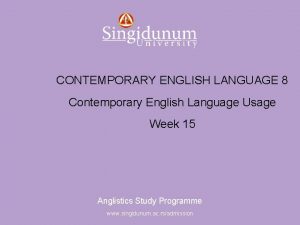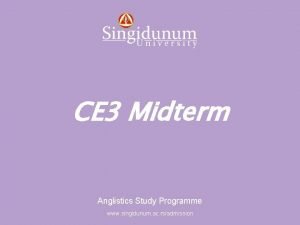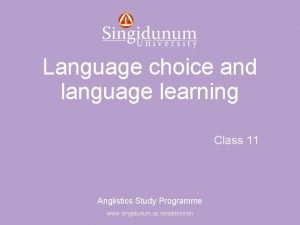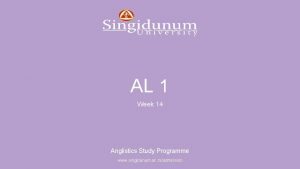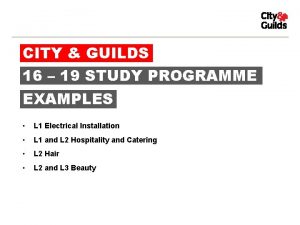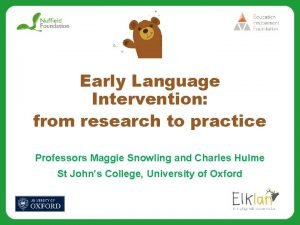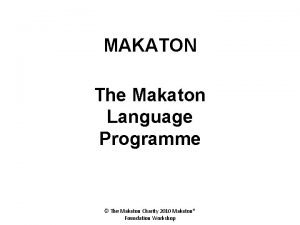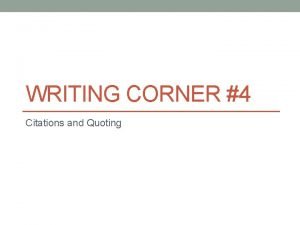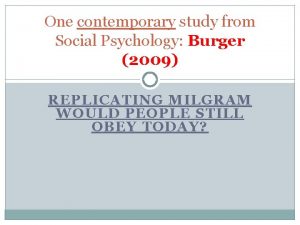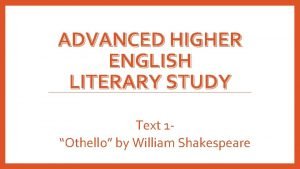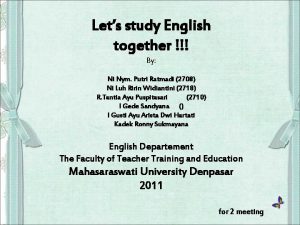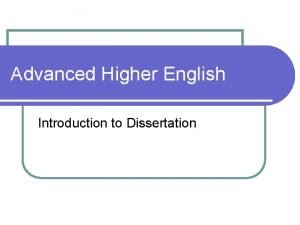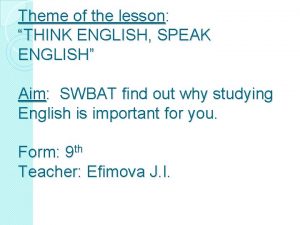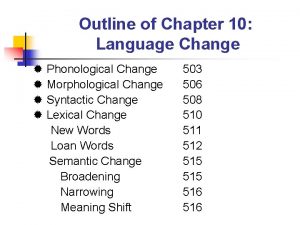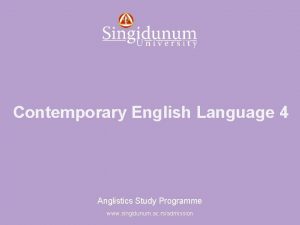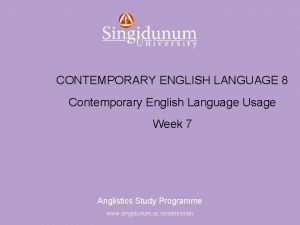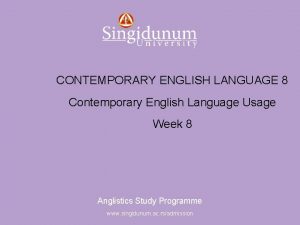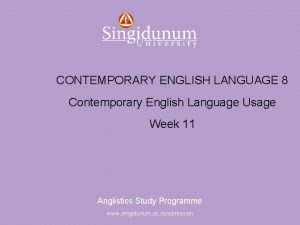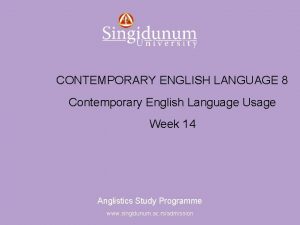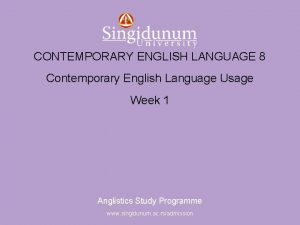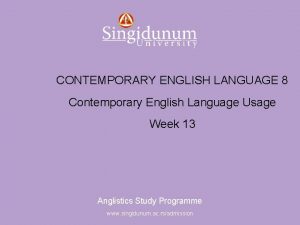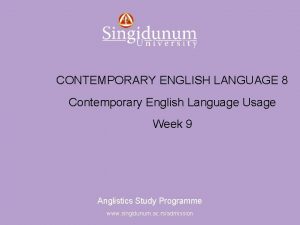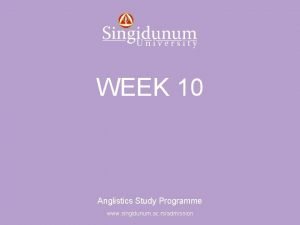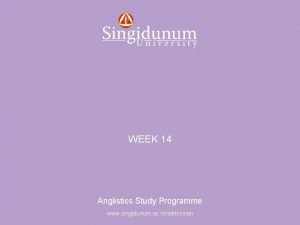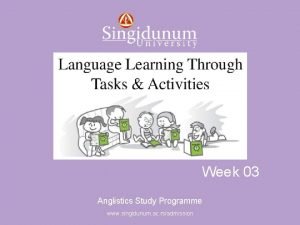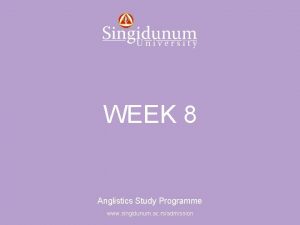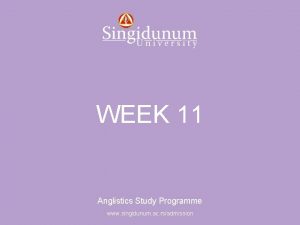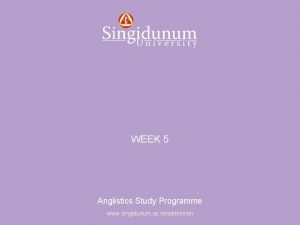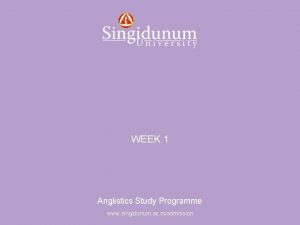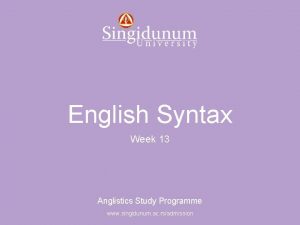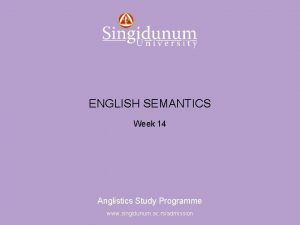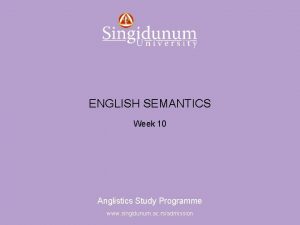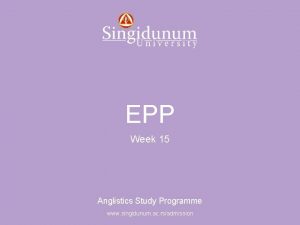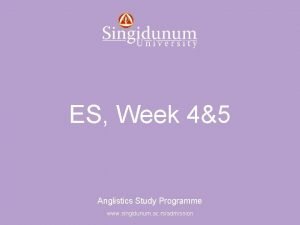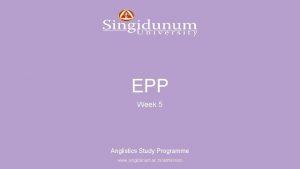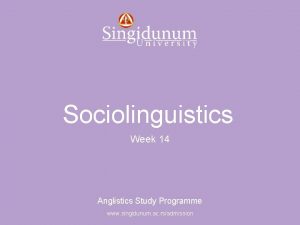Anglistics Study Programme CONTEMPORARY ENGLISH LANGUAGE 8 Contemporary




























- Slides: 28

Anglistics Study Programme CONTEMPORARY ENGLISH LANGUAGE 8 Contemporary English Language Usage Week 10 Anglistics Study Programme www. singidunum. ac. rs/admission

Anglistics Study Programme PLAN - Topic: Art and its aesthetic and psychological impact on our lives - Article: The Aesthetic attitude to art, The healing power of art - Source (The Harvard Gazette, Harvard Health Publishing, Harvard Medical School) - Enhancing vocabulary and reading skills - Work on vocabulary - tasks: English in use, transformations, word formation, adjectivenoun collocations - Source (Complete Advanced, Cambridge University Press. Cambridge English Language Assessment, C 1) Anglistics Study Programme www. singidunum. ac. rs/admission

Anglistics Study Programme Revising vocabulary 1. She was slight and fleet of _____. On second thoughts, she is the fastest person in my class.

Anglistics Study Programme Revising vocabulary Task: Which lexical item can fit all these sentences? 1. We stood ____ to see who was taller. 2. ____ housing is a form of terraced housing in which two houses share a rear wall. With the rapid expansion of the population in Victorian Britain’s factory towns during the Industrial Revolution, many thousands of ______ houses were built. 3. Our basketball team won ____ victories last weekend.

Anglistics Study Programme

Anglistics Study Programme Revising vocabulary Task: Which word can fit all these sentences? 1. Come in and ______ yourselves (down) anywhere you like. 2. Just ______ the shopping bags (down) on the table, and come and have a cup of tea. 3. I really enjoy _______ away on the guitar. 4. She _______ down most of her savings to buy the house.

Anglistics Study Programme Revising vocabulary Task: Which lexical item can fit all these sentences? 1. Could you slow down - I can't keep _____ with you. 2. I don't like the _______ of modern life. 3. No more soup, thank you. I'm ____ myself so that I have room for a dessert. 4. He ______ the room nervously. 5. The interview panel will put all candidates through their ______ especially in relation to financial skills. 6. You can get a rough idea of the size of the room by ______ it out. (examples taken from https: //dictionary. cambridge. org)

Anglistics Study Programme Watch the video Are you an art connoisseur? https: //www. youtube. com/watch? v=6 YSAMo 6 Tmk. E

Anglistics Study Programme Reading – introduction The aesthetic attitude to art – Harvard researcher’s latest book explores how and why we react to it Ellen Winner ’ 69, Ph. D. ’ 78, BI ’ 99 concentrated in English at Radcliffe, but she’d always planned to be an artist. She attended the School of the Museum of Fine Arts after college to study painting but soon realized “it was not the life I wanted. ” Instead, Winner turned her focus to psychology, earning her doctorate at Harvard. A summer job listing at the University’s career office led her to the Harvard Graduate School of Education’s Project Zero, where she interviewed with her future husband, Howard Gardner — currently the John H. and Elisabeth A. Hobbs Professor of Cognition and the senior director of the project — and took a two-year position researching the psychology of art. For her doctoral degree at the Graduate School of Arts and Sciences, Winner studied developmental psychology. She is currently a senior research associate at Project Zero and a professor of psychology at Boston College, where she founded and directs the Arts and Mind Lab, which focuses on cognition in the arts in typical and gifted children as well as adults. Her latest book, “How Art Works: A Psychological Exploration, ” is based on years of research at both Harvard and BC, and looks at art through psychological and philosophical lenses. The Gazette spoke with her recently about her findings.

Anglistics Study Programme Question 1 GAZETTE: Why do we need art? WINNER: It’s interesting to note that the arts have been with us since the earliest humans — long before the sciences — and no one has ever discovered a culture without one or more forms of art. Evolutionary psychologists have postulated various ways in which natural selection could explain why we have art. For example, fiction allows us to safely practice interpersonal relationships and those with strong interpersonal skills are more likely to mate and spread their genes. Sexual selection could also be at work: Artists might attract mates because artistic talent might signal high reproductive fitness. There is no way of testing such claims, though. My best guess is that art itself is not a direct product of natural selection, but is a byproduct of our bigger brains — which themselves evolved for survival reasons. Art is just something we cannot help but do. While we may not need art to survive, our lives would be entirely different without it. The arts are a way of making sense of and understanding ourselves and others, a form of meaning-making just as important as are the sciences. Which of the following statements is the only one clearly stated in this paragraph? a. We can with certainty prove evolutionary psychologists’ claim why we have art. b. Art helps us understand the world around us better. c. Winner is certain that natural selection resulted in art. d. Art and artistic inclination are a winning combination for a successful mating.

Anglistics Study Programme Task 2 GAZETTE: In your book you suggest that people have stronger emotional reactions to music than to the visual arts. Why? WINNER: Of course, we do respond emotionally to both music and visual art, but people report stronger emotional responses to music. I have asked my students to look at a painting for one uninterrupted hour and write down everything they are seeing and thinking (inspired by Jennifer Roberts, art historian at Harvard, who asked her students to do this for three hours). The students wrote about all of the things they started to notice, but strikingly absent was any mention of emotions. They reported being mesmerized by the experience but no one talked about being close to tears, something people often report with music. There seem to be several reasons for music eliciting stronger emotional reactions than the visual arts. The experience of music unrolls over time, and often quite a long time. A work of visual art can be perceived at a glance and people typically spend very little time with each work of art they encounter in a museum. We can turn away from a painting, but we can’t turn away from music, and so a painting doesn’t envelop us in the same way music does. In addition, music, but not visual art, makes us feel like moving, and moving to music intensifies the emotional reaction. One of the most powerful explanations for the emotional power of music has to do with the fact that the same properties that universally convey emotion in the voice (tempo, volume, regularity, etc. ) also convey emotion in music. Thus, for example, a slow tempo in speech and music is typically perceived as sad, a loud and uneven tempo as agitated, etc. The visual arts do not have such a connection to emotion. Movies may be the most powerful art form in eliciting emotion since they unfold over time, tell a story, and of course include music.

Anglistics Study Programme Task 3 GAZETTE: Can you talk more about your studies involving a person’s ability to distinguish between artwork by an abstract master and a painting done by a monkey with a paintbrush and palette? WINNER: We were interested in the often-heard claim about abstract art that, “My kid could have done that. ” We wanted to find out whether people really cannot tell the difference between preschool art and the works of great abstract expressionists like Hans Hofmann or Willem de Kooning. We also threw animal art into the mix: Chimps and monkeys and elephants have been given paint brushes laden with paint, and they often make charming, childlike markings — with the experimenter taking the paper away when the experimenter deems it “finished. ” My former doctoral student Angelina Hawley-Dolan created 30 pairs of paintings in which she matched works by abstract expressionists with works by children and animals — matched so that the members of each pair were superficially similar in color and composition and kinds of brush strokes. In a series of studies, we showed people these pairs and asked them to decide which work was better, which they liked more, and which was done by an artist rather than a child or animal. Sometimes we unpaired the works and asked people the same questions when they were presented one at a time. We found in each study that people unschooled in abstract expressionism selected the artists’ works as better and more liked, identified them as by artists rather than animals and children, and did this at a rate significantly above chance. Even when we tried to trick people (mislabeling the child work as by an artist and the artist work as by a child or animal), people recognized the actual artist’s work as the better work of art, uninfluenced by the false label. In addition, working with a computer scientist, we showed that a deep learning algorithm was able to learn to differentiate works by artists versus by children and animals, and succeeded at the same rate of correctness as did humans. And so, when you hear someone say, “My kid could have done that, ” you can say, “Not so!” -

Anglistics Study Programme Task 4 GAZETTE: What do you think was going on? WINNER: To get at this we asked another group of people to look at each of the 60 paintings, 30 by the preschoolers and animals and 30 by the great artists, one at a time and randomly ordered. We asked them to rate each work in terms of how intentional it looked, and how much visual structure they saw. The works by the artists were on average rated as more intentional and higher in visual structure. When we asked people why they thought the artists’ paintings were better works of art, they gave us mentalistic answers, saying things like, “It looks more planned” or, “It looks more thought-out. ” So, it appears that we make a clear discrimination: We perceive artists’ abstract paintings as highly planned, and those by children and animals as unplanned and somewhat random. Tellingly, we found that some paintings by artists were incorrectly identified as by children or animals, and these turned out to be the ones that had been rated as low in intentionality and structure. Our conclusion is that people see more in abstract art than they think they see. They can see the mind behind the work. Winner’s answer implies that our perception of a piece of art relies on our cognitive ability. a. True b. False

Anglistics Study Programme

Anglistics Study Programme Task 5 GAZETTE: You mention that art that evokes negative emotions can also be positive thing. Can you explain? WINNER: We gravitate toward art that depicts tragic or horrifying events (think of paintings by Hieronymus Bosch or Lucian Freud, whose portraits are often distorted and somewhat grotesque); we flock to sad or suspenseful or horrifying movies or plays or novels; we listen to music that conveys grief. Given how we strive to avoid feelings of sorrow and terror and horror in our personal lives, this presents us with a paradox — one that interested philosophers such as Aristotle, Immanuel Kant, and David Hume. This puzzle is resolved by studies showing that when we view something as art, any negative feelings about the content are matched by positive ones. For instance, one study demonstrated that presenting photographs of disgusting things like rotting food either as art photography or illustrations to teach people about hygiene led to different reactions: Those who viewed the images as art reported positive feelings along with the negative ones; those who viewed them as hygiene illustrations reported only negative feelings. Other studies have shown that people report being highly moved by art with negative content, and the experience of feeling moved combines negative affect with an equal level of positive affect. In short, we can allow ourselves to be moved by tragedy and horror in art because it is not about us; we have entered a fictional world of virtual reality. And the experience of being moved by such works is not only pleasurable, but can also be highly meaningful as we reflect on the nature of our feelings.

Anglistics Study Programme Watch the video Which aspect/ aspects of the talk drew your attention the most? https: //www. youtube. com/watch? v=Kekb 9 u. E 604 k

Anglistics Study Programme English in Use - The healing power of art Creative activities can relieve stress, aid communication, and help arrest cognitive decline The ______ of a recent documentary film, I Remember Better When I Paint, sums _____ the findings of a _______ body of research into the cognitive effects of making art. The movie demonstrates how drawing and painting stimulated memories _______ people with dementia and enabled them to _______ with the world. People with dementia aren't the only ____. Studies have shown that expressing themselves through art can help people with depression, anxiety, or cancer, too. And doing so has been linked to improved memory, reasoning, and resilience in healthy older people. The beneficial effects of creating aren't ____ on a person's skill or talents. "It's the process, not the product, " says Megan Carleton, an art therapist at Harvard-affiliated Massachusetts General Hospital (MGH).

Anglistics Study Programme

Anglistics Study Programme Work on vocabulary – adjective-noun collocations deafening fashionable gripping harsh hazardous innate instant sheer total wide clothing criticism exuberance experience feedback honesty journey noise story talent

Anglistics Study Programme Task: Complete the gaps, using the collocations from the previous slide. 1 Most teachers think it is important to give students _______ when they have done a presentation. 2 I was unable to sleep last night due to the _____ coming out of the club down the road. 3 The dancers were young and enthusiastic and the ____ of their performance thrilled the audience. 4. I’ve never seen my sister wearing ______. The way she dresses is often bizarre. 5 The minister had to deal with _____ when he introduced the new pension rules. 6 As soon as Peter painted his first picture, his

Anglistics Study Programme Quiz – transform the sentences https: //quizizz. com Join a game Enter 5 digit number Enter your name and surname

Anglistics Study Programme Work on vocabulary – transformation task 1. Tom, wouldn’t it be a good idea to take the students swimming tomorrow? how Tom, . . . . . the students swimming tomorrow? 2. I’m worried about that bruise on your hand. look I don’t. . . . . that bruise on your hand. 3. What time does your plane land tomorrow? when Can you tell. . . . . tomorrow? 4. The owner established the company in 2001. up The company. . . . . the owner in 2001. 5. Looking back, I think I was right to study mathematics at university. regret Looking back, I. . . . . mathematics at university

Anglistics Study Programme Work on vocabulary – transformation task 6. Susan has had no success with her plans to work abroad, unfortunately. through Susan’s plans to work abroad. . . . . , unfortunately. 7. I hope you were not discouraged by Sandra from going to the concert. put I hope Sandra. . . . . going to the concert. . 8. Please behave as if you are in your own house during your stay. make I’d like you all. . . . . home during your stay. 9. Leaving school made me realise that my childhood was over. brought Leaving school. . . . . me that my childhood was over. 10. I never find time to tidy my desk. round I never. . . . . my desk.

Anglistics Study Programme THE KOGOD COURTYARD At the Smithsonian Institute in Washington, the most striking _____(0) of the Kogod courtyard is its canopy roof. This vast undulating glass canopy is _______(1) by eight aluminium columns, and carefully designed to _____(2) in with the original stonework. The wave-like structure, the first of its ____(3) in the world, is constructed of deep, diamond-shaped glass panes, packed around the sides with recycled cotton to act as a perfect sound insulation. This ____(4) near perfect conditions for musical performances in the courtyard. From inside the courtyard, clouds and aircraft are clearly ______(5) through the canopy. But closer inspection reveals a milky surface covered in enamel dots, which ____(6) about two thirds of the light, _____ (7) helping to keep the courtyard cool during the baking hot Washington summers. Water is also a vital element of the design. When no event is being held, a wafer-thin ‘river’ flows through the courtyard, _____ (8) the visiting children who splash in it. The whole space is designed to be free, accessible and multi-purpose. 0 A angle B appearance C aspect D air 1 A carried B supported C sustained D propped 2 A blend B merge C combine D mix 3 A class B kind C brand D set 4 A causes B leaves C makes D creates 5 A visible B evident C apparent D obvious 6 C cuts down D puts out A puts down B cuts out

Anglistics Study Programme Word formation Performance Art began in the 1960 s in the United States as a term used to describe a live event that often included poets, (0) and filmmakers, in addition to visual artists. There were earlier (1) for this art form, including the Bauhaus in Germany, whose members used live theatre workshops to 0 - MUSIC 1 - PRECEDE 2 - RELATION 3 - GLOBE 4 - ACCOUNT 5 - PURE 6 - COMPARE 8 - MATERIAL 8 - EXPECT

Anglistics Study Programme Vocabulary game Task: Make the following sentences meaningful by finishing the second halves of the words in bold. 1. An art con_ _ _ _ is a person who kn_ _ _ a lot about and en_ _ art. 2. An ex_ _ _ _ is an event at which ob_ _ _ such as pai_ _ _ are shown to the pu_ _ _ _. 3. Something that is gr_ _ _ is so interesting or ex_ _ _ that it holds your at_ _ _ _ completely. 4. Dis_ _ _ is the ability to see the dif_ _ _ _ between two things or pe_ _ _ _.

Anglistics Study Programme Vocabulary game Task: Make the following sentences meaningful by finishing the second halves of the words in bold. 1. An art connoisseur is a person who knows a lot about and enjoys art. 2. An exhibition is an event at which objects such as paintings are shown to the public. 3. Something that is gripping is so interesting or exciting that it holds your attention completely. 4. Discrimination is the ability to see the difference between two things or people

Anglistics Study Programme
 Anglistics
Anglistics Anglistics
Anglistics Anglistics
Anglistics Anglistics
Anglistics Vce study designs
Vce study designs Study programme example
Study programme example A level english language language change
A level english language language change Nuffield early language intervention programme
Nuffield early language intervention programme Makaton definition
Makaton definition Venetian blinds contemporary study of compulsive lying
Venetian blinds contemporary study of compulsive lying Diana baumrind
Diana baumrind Ecological study vs cohort study
Ecological study vs cohort study Retrospective cohort study
Retrospective cohort study What is work study in management
What is work study in management Marty lobdell study less study smart
Marty lobdell study less study smart Phytogeographical region of india
Phytogeographical region of india Time study meaning
Time study meaning Time and motion study example ppt
Time and motion study example ppt Vce outdoor education study design
Vce outdoor education study design I study english every day present simple
I study english every day present simple How do you study english
How do you study english Advanced higher english literary study
Advanced higher english literary study Visual communication study design
Visual communication study design Vcaa english study design 2023
Vcaa english study design 2023 What does yuli do every sunday morning
What does yuli do every sunday morning Ah english dissertation
Ah english dissertation Think in english speak in english
Think in english speak in english Spoken english and broken english g.b. shaw summary
Spoken english and broken english g.b. shaw summary Tumoxan
Tumoxan
